Services
An E-Z Design Co. Landscape Services offers commercial and residential design for both indoor and outdoor landscape needs.
We provide a full scale planting design. Your landscape design will be customized to meet your specific needs and budget, whether luxury, limited, or “a little at a time.” Designs can include:
Plantscapes
- Foundation Plantings
- Island Bed Planting
- Theme Gardens
- Bird
- Herb
- Sculpture
- Specialty
Hardscapes
- Garden Walls
- Patios/Decks
- Fencing
- Privacy Elements
- Gazebos
- Lath Structures
- Arbors/Trellises
- Walkways
- Garden Lighting
Watergardens & Fountains
- Fountains
- Water Gardens
- Ponds
Contact Us
Phone:
Our Work
About Us
An E-Z Design Co. Landscape Services provides planting designs and consultations. Your landscape design will be customized to meet your specific needs and budget. We believe that to have a successfully landscaped garden, it must be unique to its environment and to your needs and budget. Our plant knowledge allows us to accommodate you and your landscape.
Landscape Designs Include:
- Plan
- Pictorial Image (if applicable)
- Plant Care Information upon request
 An E-Z Design Co. Landscape Services is pleased to offer a professional staff. A Pennsylvania Certified Horticulturist (PCH) is on staff. Our work is not limited to the state of Pennsylvania.
An E-Z Design Co. Landscape Services is pleased to offer a professional staff. A Pennsylvania Certified Horticulturist (PCH) is on staff. Our work is not limited to the state of Pennsylvania.
Elaine Zeiders brings more than 40 years of experience to An E-Z Design Co. Landscape Services. Elaine is a Pennsylvania Accredited Nurseryman and a Graduate of North Carolina State University Horticulture program. Elaine has worked as a Garden Center salesperson and is experienced in helping homeowners design their landscape. Elaine brings with her a broad spectrum of plant knowledge including, but not limited to; trees, shrubs, perennial and annual flowers, tropical plants, bulbs, and some knowledge of watergarden plants.
Plant Care Tips
Winter Care for newly planted Trees & Shrubs
Any newly planted evergreen trees and shrubs need to have Horticultural Oil or anti-dessicant applied to help protect the plants from winter wind damage. Any newly planted trees and shrubs, that loose their leaves, can benefit from using Horticultural Oil or anti-dessicant on them. If it is in a windy area, put burlap on the wind side of the plants to break the wind. Do not completely cover with the burlap. The plants need to adjust to the cold temperature.
Watering needs to be done weekly until the ground freezes, if we have less than 1 inch of rain per week. Use about 3 gallons of water per plant. Be sure to disconnect the hose after use to prevent pipes from freezing and breaking. Water is very important to winter survival! Rain gauges will freeze if water is left in them. It is a good idea to bring the rain gauges inside for the winter, to prevent breaking.
Watering Plants
Guidelines for water amounts based on soil types:
Sandy soil – 1 inch of water will penetrate up to 12 inches of soil
Loamy soil – 1 inch of water will penetrate 6-10 inches of soil
Clay soil – 1 inch of water will penetrate 4-6 inches of soil
Tree and shrub roots that absorb water and nutrients are found at a depth of 12 inches -18 inches.
Suggested water usage by plants for the seasons:
Spring – temperatures 60 – 70 degrees – 1 inch per week
Summer – temperatures 70 – 85 degrees – 2 inches per week
Summer – temperatures over 85 degrees or very windy conditions – more than 2 inches per week
Winter – ½ inch to 1 inch water (rain) not snow per week
Newly planted plants can be watered 2 inches at a time or 2 watering sessions at 1 inch based on water pressure and/or convenience. Established plants need to be watered during dry hot periods or extended windy periods (any season) a minimum of 2 inches per week. During other dry periods (winter, spring) the suggested watering is a minimum of two watering sessions a month and a maximum of one watering session a week.
Watering time guideline:
20-30 minutes per plant to get approximately 1 inch of water. It is best to measure the amount of water that comes from the hose at a slow trickle or drip tubes during the 20-30 minute time to determine if 1 inch of water has been used. If not then adjust time up or down to get the 1 inch amount. Running the hose at a slow trickle is relative to one’s interpretation of a slow trickle.
I use the 20-30 minutes as a guide and it usually works with the drip tube irrigation system that I put together for the homeowners. They can run the drip irrigation from their spigot. A timer can be added for when they are not home to water. It is a good irrigation system for those who do not need a full irrigation system.
Mulch packed by snow or rain should be loosened to help with water absorption.
Drip Irrigation
The purpose for the drip irrigation is to simplify watering your plants. Used with a timer, it is compliant with PA Department of Environmental Protection (DEP) regulations for watering plants during a drought emergency. It waters the plants efficiently without watering the weeds. In thirty minutes to one hour, you can water approximately 40 plants.





